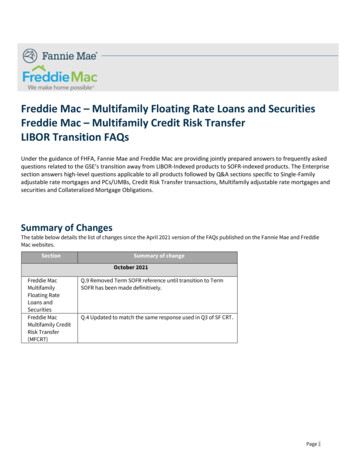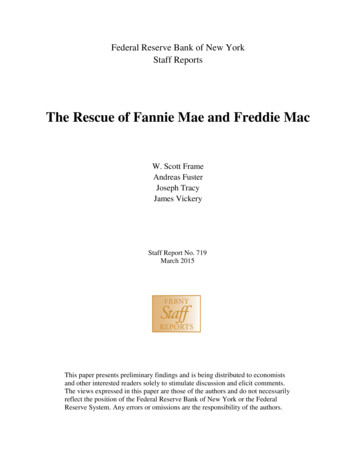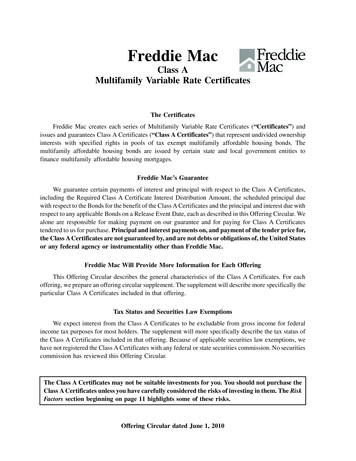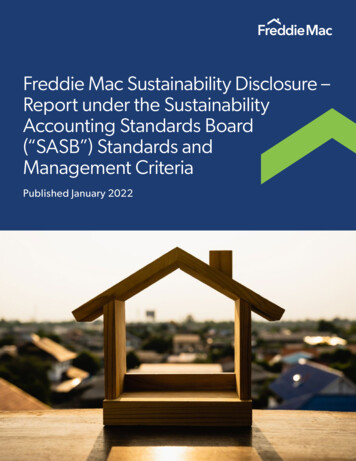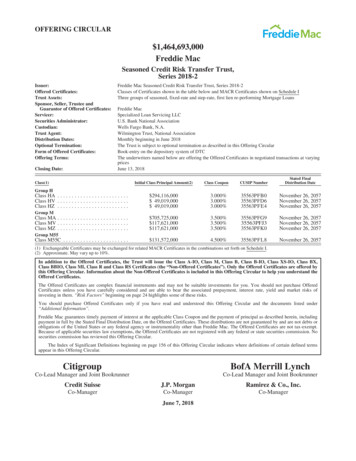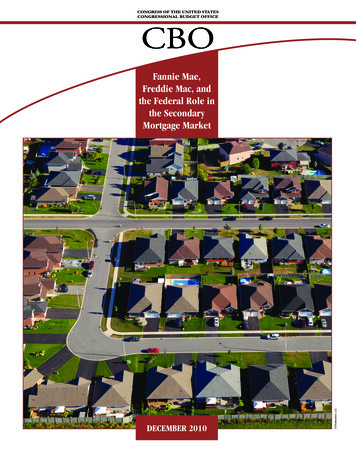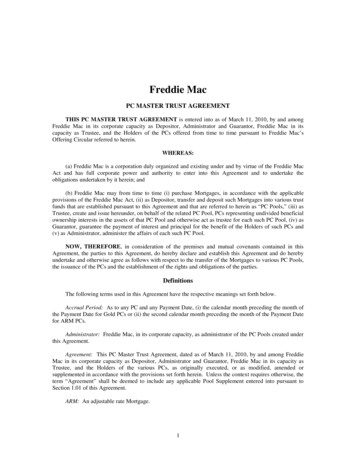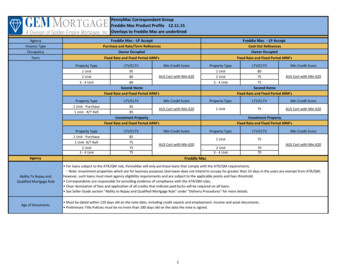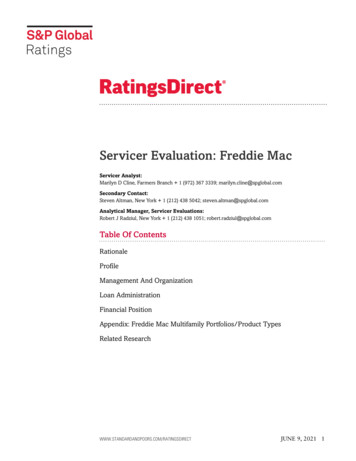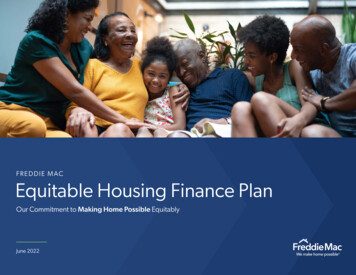
Transcription
FREDDIE MACEquitable Housing Finance PlanOur Commitment to Making Home Possible EquitablyJune 2022
Table of ContentsIntroduction 1SECTION 2: Barriers to Equitable Housing 22.1: The Foundation of Inequity in Housing 32.2: The Persistence of Inequity 62.3: Systemic Barriers 8SECTION 3: Plan Overview 15SECTION 4: Special Purpose Credit Programs 174.1: Pricing: Single-Family Loan-Level Price Adjustments 214.2: Mortgage Insurance Cost Reduction 224.3: Single-Family Title Insurance Cost Reduction 234.4: Automated Collateral Evaluation Expansion 244.5: Reserve Funds 254.6: Servicing for Sustainability (Single-Family) 264.7: Increase Diverse Multifamily Borrowers’ Access to Capital 29SECTION 5: Targeted Outreach and Interventions 325.1: Promote Down Payment Assistance Tools with Industry Partners Serving Black and Latino Communities 335.2: Finance Housing for Persons with Intellectual and/or Developmental Disabilities 355.3: Finance Permanent Supportive Housing for Persons Who Formerly Experienced Homelessness 375.4: Provide Technical Assistance on Renovation Financing for Single-Family Homes in TraditionallyUnderserved Black and Latino Communities 395.5: Expand Develop the Developer Program to Include Small Multifamily Properties 415.6: Social Bond Issuance (Single-Family) 42EQUITABLE HOUSING FINANCE PLANImplementation of the activities andobjectives in Freddie Mac’s EquitableHousing Finance Plan may be subjectto change based on factors includingFHFA review for compliance with FreddieMac’s statutory charter, specific FHFAapproval requirements and safety andsoundness standards, FHFA guidanceand directives, regulatory requirements,Senior Preferred Stock PurchaseAgreement obligations, and adversemarket or economic conditions, asapplicable.
5.7: Affirmative Marketing Plan 445.8: Equity Research Agenda 46SECTION 6: Broad Interventions to Address Systemic Barriers to Equitable Housing 516.1: Improve Fairness in Credit Scoring 526.2: Improve Fairness in Underwriting 536.3: Solutions to Address Appraisal Bias 546.4: Provide Capital for Very Small Multifamily Properties by Expanding “Linked Loan” Parameters 596.5: Support Renter and Multifamily Borrower Resource Organizations 606.6: Develop Multifamily Correspondent Lender Program for Community Development Financial Institutions,Minority Depository Institutions and Small Lenders 626.7: Facilitate Ground-Up Construction and Adaptive Reuse of Affordable and Middle-Income Rental Housingfor Individuals and Families 646.8: Rehabilitate Affordable Rental Housing 686.9: Explore and Implement Methods to Preserve At-Risk Affordable Housing through Freddie MacAffordability Restrictions 716.10: Analyze Low-Income Housing Tax Credit Properties at Risk of Lost Affordability 746.11: Analyze and Identify Affordable Rental Housing Needs 756.12: Financial Empowerment for Renters: Credit Building Through On-time Rent Reporting, CreditSmartand Equity Building for Renters 776.13: Identify and Implement Enhanced Baseline Tenant Protections 806.14: Analyze Housing Choice Voucher Availability, Efficacy and Acceptance for Renters and Homeowners 826.15: R.eform the Single-Family Rental Market with a Focus on Equity, Affordability and Sustainability 84SECTION 7: Conclusion 86SECTION 8: Appendix 888.1: Consumer Research Interview & Surveys 898.2: Industry Research Interviews 95EQUITABLE HOUSING FINANCE PLAN
IntroductionToo often, many communities of color, specifically Black and Latino communities, facedifficulty accessing a quality, affordable place to call home that enables intergenerationalwealth and mobility. Decades of discriminatory housing policies and practices directed atBlack and Latino families effectively isolated and prevented them from renting or owningan affordable home in the neighborhood of their choice or accumulating wealth throughhomeownership. The cumulative effect of these historical practices has impacted equityin housing, creating gaps in homeownership, wealth and opportunity that persist today.Freddie Mac was chartered by Congress in 1970 to provide liquidity, stability andaffordability to all corners of the U.S. housing market. For more than 50 years, we havebeen working continuously to fulfill our mission of making home possible for millions ofrenters and homeowners across the nation. However, there is more work to be done.Today, we extend our commitment of serving homebuyers and renters across all marketsand dimensions, including, but not limited to, race, ethnicity, sexual orientation andaccessibility, to focus specifically on furthering equity in housing.We recognize this is a challenge too big to be addressed lightly. We must act bothdirectly to address unique challenges and broadly to remediate systemic issues inthe housing market. We are focused on improving access to credit, housing choice,economic mobility, financial empowerment and assistance from trusted housingprofessionals. We will undertake actions that tackle the housing supply challenge,expand credit responsibly and promote sustainable housing opportunities in a safe andsound manner.“Freddie Mac’s Equitable Housing Finance Planlooks closely at current housing environment andputs forth meaningful and challenging solutionsthat advance equitable and sustainable ownershipand rental opportunities for all. It is part of FreddieMac’s effort to serve our mission expansively byincreasing access, expanding credit responsibly andbringing greater access to the American Dream.”– Michael J. DeVito, CEOThis Equitable Housing Finance Plan underscores Freddie Mac’s commitment to workacross the industry and with FHFA to create opportunities for all families to access qualityand affordable housing and to set new standards that bring more individuals closer totheir American Dream.EQUITABLE HOUSING FINANCE PLAN1
SEC TION 2Barriers toEquitable HousingFreddie Mac studied the long history of racial housing discrimination andexamined its effects that persist today. We scrutinized internal research,industry feedback and deep external ethnographic analysis to understand theunique experiences of Black and Latino communities as they relate to housing.Additionally, we reviewed comments submitted in response to FHFA’sEquitable Housing Finance Plan Request for Information (RFI) regarding thestate of equitable housing in the market, and we incorporated this input intoour approach and the specific activities included in the plan.The following sections detail the foundation and persistence of housing inequityand the five most common systemic barriers present in today’s market.
2.1: The Foundation of Inequity in HousingThe history of housing in the United States is one of wealth and opportunity — andinequity and exclusion. From the start of the modern American housing market in theearly 20th century, homeownership and wealth-building were granted overwhelminglyand intentionally to white households. The adoption of discriminatory practices wasapparent in the public domain (i.e., federal/local laws and practices) and in the privatesector, including the mortgage industry.Five high-profile examples demonstrate the scopeand impact still felt today:RedliningDeed Restrictions and Restrictive CovenantsDiscrimination in Access to Housing SubsidiesExclusionary ZoningUrban RenewalEQUITABLE HOUSING FINANCE PLAN3
Redlining – Redlining as a matter of federal policy (as opposed to solely a perniciouspractice) started and was codified in the Federal Housing Administration lending policiesand the Homeowner’s Loan Corporation (HOLC) residential security maps, whichprevented the provision of government-backed financing in many neighborhoods withminority residents.1 Generations of minority households could not purchase homes ormove to emerging suburban neighborhoods. Public-sponsored practices at all levels(federal, state and local) and private market discriminatory practices in mortgage lendingreinforced and continued to exacerbate the disparities and cut off access to wealthbuilding, economic mobility and social mobility for future generations.Deed Restrictions and Restrictive Covenants – Redlining practices and housingsegregation were often cemented through deed restrictions and restrictive covenantson properties themselves.2 This practice prevented the sale of homes to minority buyers.Homeowners’ associations and other local groups enforced these restrictions and thestatus quo of segregated neighborhoods.3Discrimination in Access to Housing Subsidies – A long history of discriminationin access to housing subsidies exists in the United States, beginning in redlinedneighborhoods and extending into the Servicemen’s Readjustment Act of 1944 (G.I. Bill).The Veterans Administration, established under the G.I. Bill, adopted the Federal HousingAdministration’s (FHA’s) racial exclusion programs when insuring mortgages for returningveterans.4 For example, large developments in prominent areas such as Levittown, NYand San Francisco, CA were financed by the Veterans Administration and upheld thesame racial restrictions. While the G.I. Bill itself did not include exclusionary language,the underwriting manual of the FHA included language stating that “incompatible racialgroups should not be permitted to live in the same communities” and prevented loans toBlack veterans from being insured.5EQUITABLE HOUSING FINANCE y restrictive covenants were meant to keep [non-white] individuals out of neighbourhoods by blocking them frompurchasing or occupying a home.”Gaucher, Hayley. “Book Note: Saving the Neighborhood: Racially Restrictive Covenants, Law, And Social Norms, byRichard RW Brooks and Carol M Rose.”Osgoode Hall Law Journal 51.2 (2014): anscripts/5266558314
Zoning – Zoning ordinances were used to prevent racial and ethnic minorities frommoving into certain neighborhoods, whether through minimum lot size and squarefootage requirements or limits on building heights.6 Housing segregation was extendedto property types. Multifamily rental properties and manufactured housing were oftenprohibited in predominantly white communities. Apartments were described as “aparasite” that would lead to the ultimate destruction of neighborhoods by the landmark1926 Supreme Court case Village of Euclid v. Ambler Realty7 which enabled the localityto establish and enforce zoning ordinances. While much has changed since 1926, thepersistent use of zoning to maintain development patterns often results in perpetuationof existing economic and de facto racial segregation.Urban Renewal – Urban renewal and highway development increased segregation.As public works projects were developed, it was common practice to displace minorityresidents, build through minority communities and disconnect communities from socialand economic opportunities. Often, displacement was coupled with the constructionof high-density “towers in the park” public housing that further disconnected minorityresidents. Underfunding of urban renewal programs over time led to a deterioration ofthe properties and the living experience.Laws, policies and practices such as these created nearly insurmountable hurdles to anequitable housing market. Although many of the last century’s discriminatory practicesand standards have been formally repealed or declared illegal or unconstitutional, theypersist in new and subtle app.201404307Village of Euclid, Ohio v. Ambler Realty Co., 272 U.S. 365 (1926)EQUITABLE HOUSING FINANCE PLAN5
2.2: The Persistence of InequityThe persistent effects of inequitable housing policies and practices can be seenthroughout the housing experience — from homeownership rates and credit gaps togeographic underinvestment and exposure to climate risk.Homeownership Gap – As of the first quarter of 2022, the Black homeownership rate(44.7 percent) and Latino rate (49.1 percent) were below the non-Latino white rate(74 percent).8 These homeownership gaps are significant and underscore the needfor us all to do better.Segregation – The level of residential segregation has not changed materially over thelast hundred years. Additionally, exclusionary zoning disproportionately and negativelyimpacts communities of edpoverty/?agreed 1&session 1EQUITABLE HOUSING FINANCE PLANWealth & Income Inequality – Generations of segregation and disparities in economicand social mobility resulted in deep wealth gaps, impeding equitable access to sustainablehousing. The average white family has accumulated seven times the wealth of the averageBlack family and five times that of the average Latino family.10 As a result, Black and Latinoborrowers are less likely to receive assistance or inheritance from their family for homepurchase down payments.11 This wealth gap is tied to the homeownership gap, as rentersgenerally have less net worth than homeowners. In 2019, homeowners had 40 times thenet worth of renters.12 Income inequality persists as well. The 2019 Black median householdincome was 43,862 and the Latino median income was 55,658, as compared to whitemedian income of 71,644.13 Further, more than half of Black and Latino renters were costburdened just prior to the COVID-19 pandemic and are now at increased risk of missingrental payments and/or facing eviction.14Credit Building Inequity – Disparities in credit scores and the ability to obtain creditnegatively influence housing access. High credit scores positively affect borrowingpower and the cost of financing, yet Black and Latino residents are more likely to beunbanked,15 have lower average credit scores and face barriers to credit al-homeownership-and-wealth-gaps ugh-homeownership/view/full reportSource: Urban Institute calculations from the 1962 Survey of Financial Characteristics of Consumers (December 31), the1963 Survey of Changes in Family Finances and the 1983–2019 Surveys of Consumer urvey/2019report.pdf6
Discrimination – Black and Latino Americans are more likely to report experiencingdiscrimination when renting or buying a home. Per a Freddie Mac survey completedin 2020, 42 percent of Black Americans and 29 percent of Latino Americans have feltdiscriminated against when renting or buying a home, compared to 11 percent of whiteAmericans. When looking to the future, 44 percent of Black renters and 39 percent ofLatino renters expect to feel discriminated against the next time they rent, comparedto 16 percent of white renters. Black and Latino homebuyers are more likely to feeldiscriminated against when buying a home: 51 percent of Black homebuyers and42 percent of Latino homebuyers versus 18 percent of white homebuyers.Undervaluation & Underinvestment – Redlining and segregated housing coincidedwith undervaluation and underinvestment in Black and Latino communities — affectingboth residents and properties. Access to credit is often tied to geography, andpredominantly Black and Latino communities often find themselves in credit deserts,making them less likely to benefit from credit-building opportunities.16 Today, wecontinue to see the effects of redlining and systemic underinvestment in historicallyredlined communities. Freddie Mac research finds that communities of color are morelikely to receive home appraisal values below contract price.17 18Climate Risk Inequity – Black and Latino households are disproportionately subjectto climate and environmental risks and hazards. When analyzing flood risk in 38 majormetropolitan areas, 8.4 percent of homes in formerly redlined areas face high flood riskcompared to 6.9 percent of homes that were deemed desirable in historical redliningmaps.19 The net effect of this was apparent after Hurricane Katrina. Four of the seven zipcodes that faced the costliest flood damage from Hurricane Katrina were at least75 percent t/20210920 home -home-purchase-appraisalsmodeling-approach20 ITABLE HOUSING FINANCE PLAN7
2.3: Systemic BarriersConsiderable historical data is available on the topic of housing inequity among rentersand homebuyers in Black and Latino communities. As shown in the image below, thisis a complex ecosystem. To fully understand its depth and to develop a robust planto improve equitable housing, Freddie Mac believed the subject warranted listeningpersonally to first-hand accounts — the contemporary voices behind the data.Contributors to theBlack Homeownership GapThis graphic represents the intricate relationshipbetween official public policies, industry practicesand individual attitudes that have contributedover time to the Black homeownership gap.GentrificationRealtor IncentiveLender IncentiveAccess to nerationalWealthDeveloper IncentiveHousingPricesNew ldingCapacityIncomeAccess toEmploymentAccess toEducationEquity inJob MarketEquity inEducationAccess toPublicTransportationAccess toTransportationExisting HousingPlaced on the MarketHousingDemandDensityAppraisalBiasHousing SupplySale of asInterestRateNIMBYismUrban Planning& ZoningRegulationsClimateChangeSocietal &Political Willto Changethe SystemLevel ofSocio-economicPolicy InterventionStrength of thePerception that theSystem is OptimalPositive RelationshipNegative RelationshipFluid RelationshipEQUITABLE HOUSING FINANCE PLAN8
Five Barriers to Equitable HousingFrom August 2021 through October 2021, Freddie Mac led an extensive research projectcombining human-centered ethnography with quantitative surveys at scale, as well as subjectmatter-expert interviews to build a deeper understanding of the equitable housing challenge.The results of this project revealed that racial disparities in the housing market are driven byfive barriers to equitable housing.Members of Black andLatino communitieshave disproportionatelyexperienced one or more ofthe following five barriers:Click on each header to go tothat section.1Individual Bias and DiscriminationExamples: Appraisal Bias Tenant Screening Discrimination Discriminatory Evictions NIMBYism Realtor Steering2Institutional/Policy Bias and DiscriminationExamples: Credit Assessment Methods Land Use and Exclusionary Zoning Equality-focused Policy Profit-maximizing Incentive Structures3Economic DisadvantageExamples: Generational Wealth Gap Asymmetric Resilience Access to Education and Employment4Limited Supply and Quality of HousingExamples of Supply Gaps: Size of Affordable Housing Gap Decline in Construction ofAffordable Units Median House Price Growth (vs. Income) Vulnerable GroupsExamples of Root Causes and Friction Points: Impacting Housing Supply and Quality Cost of Land Zoning & Permitting Cost of Construction Materials Labor Shortage Economics of AffordableHousing Project Pockets of Financial Illiquidity Quality and Lack of Services5Negative Buyer/Renter SentimentExamples: Lack of Trust in Financial Institutions Homebuyer Confidence Pervasive FearEQUITABLE HOUSING FINANCE PLAN9
Barrier 1 – Individual Bias and DiscriminationKey InsightsResearch Findings Freddie Mac ethnographic research finds that Black and Latino communitiesreport experiencing microaggressions that erode trust across the homeownershipand rental journey. These issues are not only systemic, but also personal. Theyaffect the emotional readiness and willingness to continue (or even initiate) thehomebuying process.Freddie Mac is focused and very intentional in its approach to eliminate disparities inhomeownership. We conducted two studies to determine whether minorities are morelikely to receive an appraisal value that is lower than the contract price during purchasetransactions (referenced as “Appraisal Gap”).21 22 Our studies found: Black and Latino buyers report navigating a general feeling of knowing where they arewelcome and where they are not. For some it’s a non-issue, but for many it is a factorthat further limits desirable inventory. Appraisers’ opinions of home value are more likely to fall below the contract price inBlack and Latino census tracts, and the extent of the gap increases as the percentageof Black or Latino people in the tract increases. Black and Latino applicants receive lower appraisal values than the contract pricemore often than white applicants. Properties in Black and Latino tracts receive appraisal values lower than the contractprice more often than those in white tracts. As the concentration of Black or Latinoindividuals in a census tract increases, the appraisal gap increases. Our modeling results show that after controlling for a list of appropriate factors:ºProperties in Black and Latino tracts receive appraisal values lower than thecontract price more often than those in white tracts.ºThe likelihood for properties in Black tracts and Latino tracts to receive “appraisalvalue lower than contract price” increases as the Black or Latino concentrationincreases in the tracts.ºWhen “appraisal value lower than contract price” takes place, houses in Black tractsare appraised slightly lower relative to comparable homes in White tracts in termsof the percent difference between the appraisal value and the contract price.Freddie Mac continues to be a proactive industry player in seeking to analyze andbetter understand factors contributing to the results found in these appraisal reports.We remain fully committed to testing and learning with the goal of achieving moreconsistent valuation outcomes across all communities, including reliance on automatedvaluation-based ight/20210920 home appraisals.page?22 aisalsmodeling-approachEQUITABLE HOUSING FINANCE PLAN10
Barrier 2 – Institutional / Policy Bias and DiscriminationKey Insights Continued reliance on FICO scores across industries disfavors Black and Latinohouseholds whose credit scores are often lower. This is due in part to their largestcontinual payment — rent — not being reported to credit bureaus. Land use and exclusionary zoning raise the cost of land and limit accessibility ofhigher-opportunity neighborhoods for lower-income families. State and local jurisdictions too often establish a low standard for tenant rights orallow landlords to deny tenants’ applications based on their source of income. Ecosystem actors are hesitant to build and launch equity-driven programs thatprovide affirmative support to minorities due to a lack of clear guidance regardinghow those activities would be interpreted considering anti-discrimination aspects ofThe Fair Housing Act and Equal Credit Opportunity Act (ECOA).23 Lenders and real estate agents have the greatest impact on homebuyers’ experience,and ideally would have commensurate incentive to deliver equitable service.For example, to expedite the home selection process, agents may steer minorityhomebuyers, thereby reducing their housing choice and their trust in the process.23 mEQUITABLE HOUSING FINANCE PLAN11
Barrier 3 – Economic DisadvantageKey Insights The gap in generational wealth between minorities and non-minorities is a keyeconomic disadvantage that perpetuates the homeownership gap. Programsthat focus solely on equal opportunity are unlikely to succeed in closing racialhomeownership gaps. Black and Latino families on average have less in emergency savings and are less likelyto have a friend or family member who can offer financial help.24 Asymmetric resilience — when system shocks, like natural disasters, public healthemergencies and economic downturns occur, marginalized communities are proneto experiencing compounded negative impacts as it relates to financial health andsecure housing and may face a limited range of quality home buying options orchallenges in retaining homeownership. Minority homebuyers often lack the same level of access to information and/or socialnetworks about navigating the homebuying journey as most white homebuyers andmay make detrimental buying and/or financing decisions as a result.24 mEQUITABLE HOUSING FINANCE PLAN12
Barrier 4 – Limited Supply and Quality of HousingKey Insights Housing supply remains a core economic barrier. The overall supply and demandgap for housing units in the U.S. has been growing at a rate of 600,000 units peryear (or 7 Million total) and 325,000 units per year for affordable housing units( 3.5 Million) since 2010.25 As a result, 1 in every 3 U.S. households continues to be cost burdened with limiteddisposable income to spend on other basic needs. The housing affordab
objectives in Freddie Mac's Equitable . Housing Finance Plan may be subject . to change based on factors including FHFA review for compliance with Freddie Mac's statutory charter, specific FHFA approval requirements and safety and soundness standards, FHFA guidance and directives, regulatory requirements, Senior Preferred Stock Purchase
